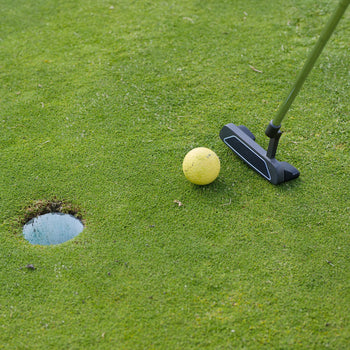Golf Terms Every Golfer Should Know
If you are brand new to golf, many of the golf terms likely seem foreign to you. Our goal is to teach you the common golf terminology so that you can feel comfortable joining your friends on the course.
Scoring Golf Terms
Some of the golf words you will hear refer to the scoring. See the list below for some of the most common scoring terms:
- Ace: hole-in-one
- Par: the number of strokes a golfer should make on the hole, based on difficulty and length. Holes will be either par 3, par 4, or par 5
- Albatross (or double eagle): scoring a hole on your second shot on par 5
- Eagle: scoring two shots below par (ie, if playing par 4, you score a 2 on the hole)
- Birdie: scoring one shot below par
- Bogey: scoring one shot above par
- Double Bogey: scoring two shots above par
- Triple Bogey (or Trip): scoring three shots above par
- Penalty: each stroke added to a player’s score for violation of the rules or losing the ball
- Match play: a competition scored by the number of holes won or lost
- Stroke play: a competition scored by the total number of strokes for one round

Areas of the Golf Course
You can save yourself from embarrassment by becoming familiar with the specific areas of the golf course. The golf terms below will be most helpful:

- Tee box: a marked spot for each hole from which you hit your tee shot
- Green: where the hole and flag are located
- Fairway: the shorter-mown area of a golf course between the tee box and the green, and ideally, this is where your tee shot will land
- Fringe: the higher-mown grass surrounding the green
- Rough: the tallest grass that surrounds the fairway and green
- Bunker: a sand trap designed to make holes more difficult
- Lip: edge of the hole
Golf Terms All About the Shot
To become a good shot yourself, you should learn the different types of shots. Read the terminology below to learn which kinds of shots you should practice and which you should avoid:
- Approach: a short or medium shot to the pin or putting green
- Putt: when you are using your putter on the green. You want to have as few putts as possible
- Gimme Putt: when your putt is so close to the hole that your competitors give you the putt (These are not allowed in tournaments either)
- Mulligan: most common among beginners, a mulligan is when you reattempt your previous shot because you were dissatisfied with the outcome (These are not allowed in tournament golf)
- Shank: when a shot is hit off the neck or heel of the golf club and the ball immediately shoots right
- Topped shot: when the bottom of the club strikes the top half of the ball, resulting in the ball only traveling a few yards
- Whiff: to swing and miss the ball completely. This counts as a stroke
- Carry: the distance a ball travels between impact and hitting the ground
- Follow-through: the end of a swing from striking the ball to completing the motion

Other Common Golf Terms
Just as important as the golf terms covered earlier in this post are the ones below. The faster you learn them, the sooner you can apply your knowledge on the golf course.

- Caddie: a person who is hired to carry your clubs and give advice during the round
- Fore: a warning you yell to other golfers if you hit the ball in their direction
- Slope: the difficulty rating of a golf course. The higher the slope, the more difficult the golf course
- Handicap: the number of strokes shot over par during a round of golf
- Scratch: a golfer who plays at a “scratch” level has a handicap of 0, which is the goal for all amateur golfers. Scratch golfers usually shoot par or better
- Yips: when you have muscle spasms or mental blocks that hinder your golf putting performance
- Above the hole: when the ball is positioned on a slope so that the next putt is downhill. Downhill putts are riskier, so a golfer should try to keep the ball below the hole at all times
- Below the hole: when your next putt is uphill
- Drop: when the ball is lost or unplayable, a golfer can drop a new ball from arm’s length at shoulder height onto the course with a penalty
- Interlocking grip: common way of holding the golf club, especially for golfers with small hands. A right-handed player interlocks the pinky finger of the right hand with the index finger of the left hand
- Lie: the resting place of the ball on the course. This also refers to the angle at which the clubhead is set on the club shaft
- Marker: a thin, flat item used to mark the position of the golf ball to prevent your ball from obstructing other players’ shots
- Pin: the flag stick
- USGA: The United States Golf Association, formed in 1894
Learn these golf terms to gain a good beginner’s understanding of the sport. Soon you will be speaking fluent golf. To learn more about golf, check out our blog.

